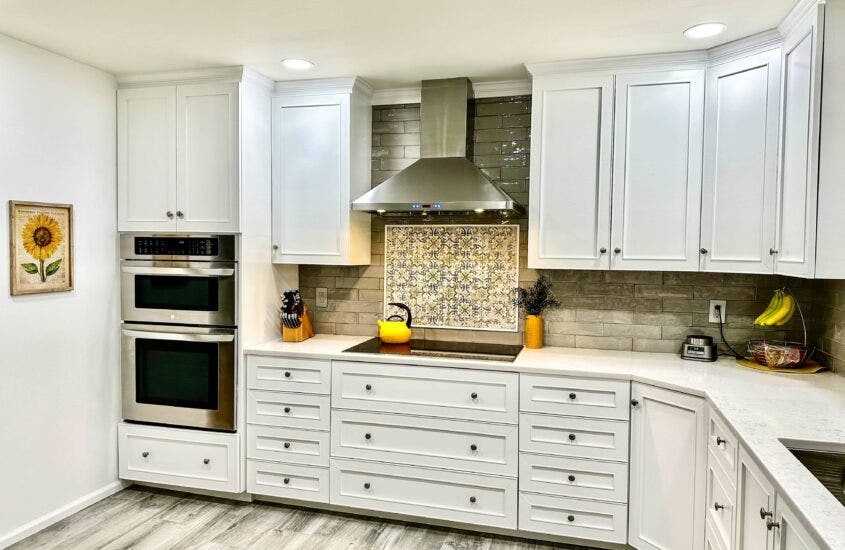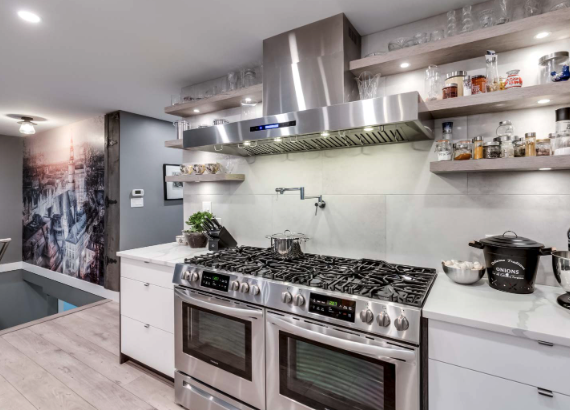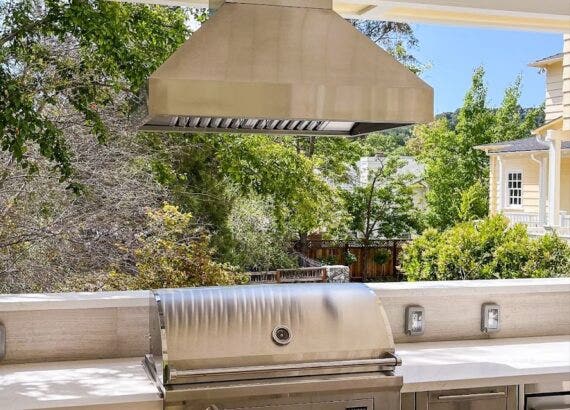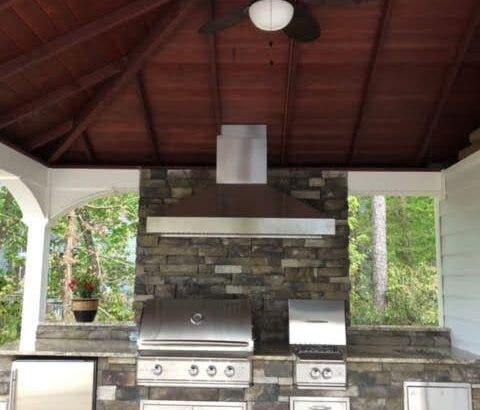When Do I really need a range hood? (w/ Quiz)

The more cooking you do that produces smoke, grease, condensation, aromas, or uses high heat, the more likely you’ll need a range hood to maintain air quality. Even electric or induction ranges benefit from range hoods due to particles, steam, and odors.
Here are a few different cooking situations that would be greatly benefited from having a proper sized and properly installed hood:
Frying or sautéing – When frying foods in oil or butter at high temperatures, it produces a lot of smoke, grease splatter, and odors that need to be ventilated. This includes cooking things like eggs, meats, stir-fries, etc.
Broiling or grilling – Broiling and grilling meats over an open flame creates smoke and grease that should be captured by a hood.
Pan searing or browning – Getting a nice sear on meats or other foods requires high heat that generates vapors and airborne particulates.
Boiling or simmering – Even boiling large pots of liquids like soups, stews or pasta produce enough steam and condensation to warrant a hood.
Deep frying – Deep frying foods like donuts, fries, etc. produces oils and moisture that need strong ventilation.
Stir frying – The constant tossing motion of stir frying creates a lot of visible steam and smoke.
Cooking aromatic foods – Pungent foods like fish, onions, garlic, or curry create smells and airborne particles.
High heat cooking methods – In general, cooking with high stovetop heat like grilling, torching, branding, etc. requires a range hood.
Table of Contents
How do range hoods help with those?
There are a few key ways range hoods manage smoke, grease, moisture, and smells produced during cooking: ventilation, ducting, filtration, and strategic airflow all contribute to providing a cleaner, safer work environment for the cook.
Questions to ask yourself to know if you need a range hood
Scan the questions below and read the ones that stand out to you.
How Much Do You Cook?
Cook frequently? The more often you cook, the more you’ll benefit from venting smoke, grease and vapors outside your kitchen. Occasional reheating doesn’t produce as many byproducts necessitating ventilation. But if you regularly fry, sauté, boil, broil or grill, a range hood becomes incredibly useful.
The residuals from repeated cooking – smoke, moisture, odors and grease – accumulate over time without proper ventilation. So consider your cooking frequency and style. Frequent frying, searing, grilling and more? Don’t cook without a hood.
What Types of Cooking Do You Do?
The cooking methods you use most often should guide your decision about a range hood. Frying and sautéing create lots of smoke and grease splatter. Searing meats at high temperatures also generates vapors that a hood will capture.
Do you broil or grill? That exposes food to open flames, producing smoke and grease a hood will mitigate. Even boiling large pots of soupy foods produces steam a hood would ventilate. If your go-to cooking methods are higher heat and higher smoke, then installing a range hood is worthwhile.
But if your cooking is mostly baking, microwaving, or using a slow cooker, a ventilation system may not provide as much benefit. So consider the types of cooking you do regularly. The more you fry, sear, broil and grill, the more a hood will contribute clean air.
How Aromatic Is Your Cooking?
Pungent aromas are a key indicator. Do you cook strongly scented foods like fish, garlic or onions? Spices like curry and chili peppers can also linger in the air. Even certain oils have distinctive smells during cooking. Powerful food odors are no match for ineffective ventilation.
Without an hood, they permeate countertops, curtains and clothing. But a high-quality hood traps food smells before they overtake your kitchen. The right CFM rating paired with ducting outside is key for odor control. No one wants their kitchen constantly reeking of last night’s fried fish.
So if your cooking is redolent with spice, aroma and distinctive ingredients, a range hood will clear the air. The right ventilation system filters out the smell as well as the smoke.
Do You Notice Cooking Odors or Residue?
Lingering odors and oily residue are telltale signs. If cooking smells persist in your kitchen long after meals, inadequate ventilation is likely the culprit.
Without sufficient airflow, food odors have nowhere to go. The absence of a hood also allows vaporized oil to resettle across your kitchen. Accumulated grease on countertops and backsplashes means particles escaped airborne. A layer of sticky film signals that a hood would provide added benefit. But a quality range hood transports and traps cooking byproducts.
The right CFM moves air swiftly outside rather than recirculating smells. And filtration snags grease before it spreads and condenses. So take note of any enduring odors or oily deposits after cooking. These clues mean a hood will dramatically improve your air quality.
Does Your Kitchen Feel Humid or Greasy?
Clammy countertops and foggy windows are red flags. High humidity after cooking indicates insufficient ventilation. Pots boiling over and steaming foods release detectable moisture into the air. Without proper airflow, that humidity lingers – condensing on cool surfaces. Excessive grease clinging to cabinets and walls also hints that particles are escaping airborne.
Heavy cooking generates vaporized grease that resettles across kitchen surfaces without a hood. The result is an unpleasantly oily feel throughout the kitchen. But a powerful ventilation system extracts and vents both humidity and grease before they spread. The right CFM rating removes moist air quickly through ducting. Quality filtration also traps greasy particulates rather than allowing them to coat your kitchen.
So if high humidity persists or grease accumulates after cooking, a proper range hood is the solution.
Is Your Kitchen Well Ventilated?
Consider your kitchen’s overall ventilation. Does it lack exterior windows or air exchange with other rooms? Range hoods work best alongside proper airflow from windows or fans. Insufficient ventilation only compounds cooking byproducts lingering in the kitchen. But effective ventilation through windows, for example, can complement a hood rather than fully replacing one.
Strategic room air patterns maximize extraction potential. So a hood alone may struggle in a poorly ventilated space. Factor your kitchen’s general airflow into the ventilation equation.
Lacking windows or air exchange raises the need for a range hood. But existing ventilation supports a hood’s function. For clean and clear kitchen air, effective ventilation and range hoods go hand in hand.
Do You Have Sensitivities to Cooking Byproducts?
Consider personal sensitivities. Odors, fumes and dryness affect everyone differently. More sensitive people suffer more without sufficient kitchen ventilation. Each individual has varying thresholds for airborne irritants. Asthma and allergies may heighten reactions to cooking byproducts.
For those susceptible, a range hood can provide welcome relief. It whisks away problematic particulates before they trigger a reaction. Potent cooking odors can also overwhelm sensitive individuals first. A quality ventilation system traps and vents these smells rather than allowing them to linger.
So if certain byproducts make you wheeze or feel unwell, a hood could help. Having a good hood with the right CFM rating will clear the unique irritants that affect you most out of your cooking space. Don’t settle for discomfort in your own kitchen.
A range hood helps filter out cooking byproducts, some of which could be causing reactions.
Is the Cooktop Gas or Electric?
The fuel source matters. Gas cooktops and ranges emit combustion byproducts like nitrogen dioxide, carbon monoxide and water vapor. This expands the types of particulates a hood must address beyond just smoke and grease. Gas cooking also typically involves open flames, increasing smoke production.
The resulting increase in airborne contaminants makes a hood even more critical.
Electric and induction cooktops still benefit from ventilation due to grease, moisture and odors. But gas introduces more particulate types that high CFM ducted range hoods help clear. So, while all cooktops warrant consideration of a ventilation system, gas most expands the need.
Open combustion doubles the importance of quality ventilation. Don’t inhale dangerous gases alongside your dinner. Let a powerhouse range hood remove the extra byproducts generated by gas fuel.
How Small Is Your Kitchen?
Consider kitchen size and layout. More compact kitchens increase the need for contained ventilation. In tight quarters, cooking byproducts have less room to dissipate. A range hood provides critical containment by capturing smoke, grease and humidity at the source.
Without containment, cooking residues spread rapidly across surfaces in smaller kitchens. Large open layouts dilute some byproducts but still benefit from vented removal. However, tiny galley kitchens absolutely require an effective ventilation system for air quality.
Limited space only amplifies the accumulation hazard without one. And overhead mounted range hoods take up no precious real estate. So while all kitchens need ventilation, small tight spaces most require the air management of an installed hood.
Don’t let layout limitations leave you choking on cooking fumes. A space-saving hood clears the air no matter the kitchen size.
The “Do I Need a Range Hood” Quiz
Here are those same questions again to assist you in knowing your situation a little better. You can use these as talking points with your significant other or you can each take the quiz separately and then compare answers.
How Much Do You Cook?
What Types of Cooking Do You Do?
How Aromatic Is Your Cooking?
Do You Notice Cooking Odors or Residue?
Does Your Kitchen Feel Humid or Greasy?
Is Your Kitchen Well Ventilated?
Do You Have Sensitivities to Cooking Byproducts?
Is the Cooktop Gas or Electric?
How Small Is Your Kitchen?
Is There Room for a Hood Over the Cooktop?
Worth Noting – Home Ventilation Codes
Many building codes and home insurance policies require proper kitchen ventilation. Local regulations may mandate hoods for gas stoves or commercial-grade equipment. Improper venting could violate codes or clauses. An inspector or insurance agent can clarify requirements. Stay up to code and keep your policy intact with suitable range hood ventilation.
Also, consider noise levels.
Range hoods vary greatly in noise output. Powerful motors and high CFM ratings often come with increased decibels. Consider noise tolerance, open kitchen layouts, adjoining living spaces, and proximity to bedrooms that could be disturbed.
Quieter hoods may sacrifice some venting power but maintain peaceful environments. Balance strength and noise depending on your needs.
There you have it
Deciding on a range hood requires assessing cooking habits, space constraints, sensitivities, and existing ventilation. Carefully match CFM power and features to your needs and kitchen layout. And follow any applicable building codes for your local regulations.
With some reflection on your situation, you can select the ideal range hood to create a more comfortable, safe, and pleasant cooking environment.







Comments are closed.